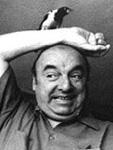 繁体
繁体

巴勃罗·聂鲁达(Pablo Neruda 1904~1973)智利诗人。原名内夫塔利·里卡多·雷耶斯·巴索阿尔托。生于铁路工人家庭。圣地亚哥智利教育学院法语专业毕业。曾任驻外大使。1945年当选国会议员,同年加入智利共产党,1946年后被迫流亡国外。1952年回国,1957年任智利作家协会主席。
巴勃罗·聂鲁达的全部作品集
巴勃罗·聂鲁达(Pablo Neruda 1904~1973)智利诗人。原名内夫塔利·里卡多·雷耶斯·巴索阿尔托。生于铁路工人家庭。圣地亚哥智利教育学院法语专业毕业。曾任驻外大使。1945年当选国会议员,同年加入智利共产党,1946年后被迫流亡国外。1952年回国,1957年任智利作家协会主席。聂鲁达的诗作继承了智利民族诗歌的传统,又借鉴了西班牙民族诗歌的特色。并受到了波特莱尔、韩波等法国现代派诗人的影响,甚而追求惠特曼的自由诗形式。他的早期诗作,如诗集《霞光》(1923)、《二十首情诗和一支绝望的歌》(1924)带有浓厚的浪漫主义色彩。其后,运用隐喻象征手法创作的诗集《地球上的居所》(1933)又带有孤独痛苦情绪。西班牙人民反法西斯斗争开始后,他的诗作进入明快、进步而多产的第三创作阶段。著名长诗《西班牙在我心中》(1937)讴歌西班牙人民和国际纵队的英勇战斗,谴责法西斯匪徒的非人暴行,被译成多国文字在反法西斯前线广泛流传。收入1950年出版的《诗歌总集》中的组诗《伐木者醒来吧》(1948),以奔放豪迈的笔触赞美被压迫被奴役民族和人民的反抗斗争,通篇用无韵的自由诗体和排比句法激起读者感情上的起伏,成为拉丁美洲文学史上具有高度思想性和艺术性的诗歌杰作。其著名作品还有诗集《葡萄和风》(1954)、《逃亡者》、《英雄事业的赞歌》等,对拉丁美洲的诗歌产生了深远影响。聂鲁达于1971年获诺贝尔文学奖。
Pablo Neruda (1904-1973)Pablo Neruda was born in Parall, Chile. He studied in Santiago in the twenties. From 1927 to 1945 he was the Chilean consul in Rangoon, in Java, and then in Barcelona. He joined the Communist Party after the Second World War. Between 1970 and 1973 he served in Allende’s Chilean Government as ambassador to Paris. He died shortly after the coup that ended the Allende Government.Neruda's career as a poet began with love poetry and ended with love poetry. One of his very last works, written only days before his death, is The End, a love poem to [his wife] Matilde. There were, of course, changes; there were deviations during the period of Residence on Earth, for example; there were turns and innovations during the period of political and epic poetry that began in the late thirties and culminated in 1950 with Canto General, but there was also a remarkable continuity. Erotic poetry and love poetry were for Neruda an important, essential part of his poetic life.Pablo Neruda was one of the most prolific poets of our century. To trace the development of even one aspect of his poetic world is far from easy. Yet in the case of his erotic poetry and his love poetry the outline of that development is clear enough. The early Neruda, from his first published book, Crepusculario, and then especially in Twenty Poems, is a sensualist and a materialist in his approach to love and woman…. [In Twenty Poems] Neruda intensifies the complete fusion between woman and Nature. Joy and despair, like Marisol and Marisombra, mingle and alternate in this book, but whatever the emotion of the moment, the poet is constant in his identification of woman with Nature, in his use of Nature imagery to describe woman, and in his conception of woman as a vehicle for a return to Nature. In these richly sensual poems, the style is still on the whole modern Romantic with symbolist overtones and the first few hints of the newer, more disturbing poetic styles. Yet they remain constructive poems, in that they are organized around experiences in which real human beings, Neruda himself and the women he loved, provide a stabilizing platform upon which each poem is built.